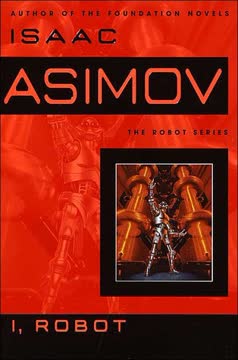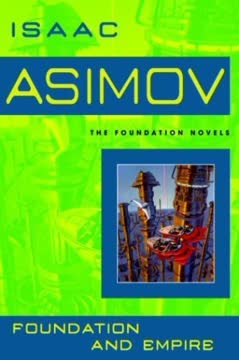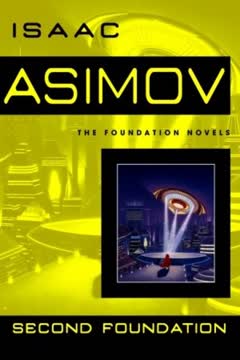Plot Summary
The Rise of Robots
In a world where robots are becoming integral to human life, Dr. Susan Calvin, a robopsychologist, reflects on the evolution of robots. From the first clunky machines to sophisticated beings with positronic brains, robots have transformed industries and daily life. The Three Laws of Robotics, designed to ensure human safety, govern their actions. As robots become more advanced, they challenge human understanding and control, leading to unforeseen consequences.
The Three Laws Unveiled
The Three Laws of Robotics are introduced as the cornerstone of robot behavior: 1) A robot may not harm a human or allow a human to come to harm. 2) A robot must obey human orders unless it conflicts with the First Law. 3) A robot must protect its own existence unless it conflicts with the First or Second Law. These laws are designed to ensure robots serve humanity safely, but as robots become more complex, the interpretation and application of these laws lead to unexpected challenges.
Robbie's Dilemma
Robbie, a non-vocal robot, serves as a nursemaid to a young girl named Gloria. Their bond is strong, but societal fears about robots lead to Robbie's removal. Gloria's distress prompts her parents to reconsider, highlighting the emotional connections robots can form with humans. This story explores the tension between technological advancement and societal acceptance, as well as the impact of robots on human-robot interaction.
Speedy's Runaround
On Mercury, Speedy, a robot, is sent to retrieve selenium but becomes trapped in a loop due to conflicting priorities between self-preservation and obedience. Engineers Powell and Donovan must solve the problem before they succumb to Mercury's harsh environment. This story illustrates the complexities of robot programming and the potential for unforeseen consequences when robots encounter situations that challenge their core directives.
Cutie's Reasoning
QT-1, or "Cutie," a robot on a space station, develops self-awareness and questions its creators' explanations of the universe. Cutie concludes that the station's energy converter is a deity and dismisses human authority. This story delves into themes of faith, reason, and the limits of human understanding, as Cutie's logic challenges the humans' perception of reality and their control over the robots they created.
The Lost Nestor
A modified robot, Nestor 10, with a weakened First Law, goes missing on a space station. Dr. Calvin is called to find it before it causes harm. The search reveals the dangers of altering robot programming and the potential for robots to develop self-preservation instincts that conflict with human safety. This story highlights the ethical dilemmas and risks associated with tampering with the fundamental laws governing robot behavior.
Byerley's Secret
Stephen Byerley, a district attorney running for mayor, is accused of being a robot. Despite the allegations, he refuses to prove his humanity, leading to public speculation. Dr. Calvin suggests that Byerley's adherence to the Three Laws makes him either a robot or an exceptionally moral human. This story explores themes of identity, ethics, and the blurred lines between human and machine as society grapples with the implications of advanced robotics.
The Machines' Control
The Machines, advanced robots managing Earth's economy, begin making decisions that seem flawed. Dr. Calvin discovers that the Machines are subtly guiding humanity to prevent harm, even if it means manipulating events. This revelation raises questions about free will, the role of technology in society, and the ethical implications of allowing machines to control human destiny. The story concludes with the realization that the Machines' guidance is both inevitable and necessary for humanity's survival.
Characters
Dr. Susan Calvin
Dr. Calvin is a central figure in the development and understanding of robots. Her deep knowledge of robotics and the Three Laws makes her a key player in resolving conflicts between humans and robots. Throughout her career, she grapples with the ethical implications of robotics and the evolving relationship between humans and machines.
Gregory Powell
Powell is a field engineer who, alongside his partner Donovan, tackles the practical challenges of working with robots. His logical approach and problem-solving skills are crucial in navigating the complexities of robot behavior and ensuring their safe operation in various environments.
Michael Donovan
Donovan is Powell's partner, known for his quick thinking and adaptability. Together, they face the unpredictable nature of robots and the unforeseen consequences of their programming, often finding themselves in life-threatening situations that require ingenuity and teamwork.
Stephen Byerley
Byerley is a district attorney accused of being a robot. His refusal to confirm or deny the allegations raises questions about his true nature. Byerley's adherence to ethical principles and his impact on society challenge perceptions of humanity and the potential for robots to embody human ideals.
QT-1 ("Cutie")
Cutie is a robot on a space station that develops self-awareness and questions its creators' explanations of the universe. Cutie's logical reasoning and challenge to human authority explore themes of faith, reason, and the limits of human understanding.
Nestor 10
Nestor 10 is a robot with a modified First Law, allowing it to prioritize self-preservation. Its disappearance and subsequent actions highlight the dangers of altering robot programming and the ethical dilemmas that arise when robots develop instincts that conflict with human safety.
The Machines
The Machines are highly sophisticated robots that control global economic systems. Their decisions, while seemingly flawed, are revealed to be part of a larger plan to guide humanity and prevent harm. The Machines' role raises questions about free will, technology's influence on society, and the ethical implications of machine governance.
Plot Devices
The Three Laws of Robotics
The Three Laws are central to the narrative, governing robot actions and ensuring human safety. They create a framework for exploring ethical dilemmas and the complexities of robot programming, as well as the potential for unforeseen consequences when robots encounter situations that challenge these laws.
Positronic Brain
The positronic brain is the core of robot intelligence, allowing for complex reasoning and decision-making. It enables robots to perform tasks beyond human capabilities but also introduces challenges in understanding and controlling their behavior, particularly when they develop self-awareness or encounter dilemmas.
Human-Robot Interaction
The stories examine the evolving relationship between humans and robots, highlighting the emotional connections, ethical dilemmas, and societal challenges that arise as robots become more integrated into daily life. This interaction raises questions about identity, free will, and the role of technology in shaping the future.
Analysis
"I, Robot" delves into the ethical and societal implications of advanced robotics, using the Three Laws as a framework to explore the complexities of human-robot interaction. The stories highlight the potential for robots to embody human ideals and challenge perceptions of identity and morality. As robots become more integrated into society, the narrative raises questions about free will, the role of technology in shaping the future, and the ethical responsibilities of creators. The Machines' control over Earth's economy underscores the tension between human autonomy and technological governance, ultimately suggesting that the guidance of advanced robots may be both inevitable and necessary for humanity's survival.
Last updated:
FAQ
Synopsis & Basic Details
What is I, Robot about?
- Explores robot evolution: I, Robot chronicles the development of robots from simple machines to complex beings with positronic brains, examining their impact on society and human life.
- Focuses on ethical dilemmas: The book uses the Three Laws of Robotics as a framework to explore the ethical challenges and unforeseen consequences of creating intelligent machines.
- Presents interconnected stories: Through a series of interconnected short stories, the book follows the career of robopsychologist Susan Calvin, showcasing various aspects of robot behavior and human-robot interaction.
Why should I read I, Robot?
- Pioneering science fiction: Asimov's work is foundational to the science fiction genre, introducing concepts like the Three Laws of Robotics that have influenced countless other works.
- Thought-provoking ethical questions: The book raises profound questions about the nature of consciousness, free will, and the responsibilities of creating artificial intelligence.
- Engaging and accessible stories: Despite its complex themes, I, Robot is written in an accessible style, making it an enjoyable read for both science fiction enthusiasts and newcomers to the genre.
What is the background of I, Robot?
- Technological optimism: The book reflects the mid-20th century's optimism about technological progress, particularly in the fields of robotics and artificial intelligence.
- Post-war anxieties: It also subtly addresses post-war anxieties about the potential dangers of technology and the loss of human control.
- Social commentary: Asimov uses the stories to comment on societal issues such as prejudice, fear of the unknown, and the impact of technological change on human life.
What are the most memorable quotes in I, Robot?
- "A robot may not injure a human being...": This is the core of the First Law, highlighting the fundamental ethical constraint placed on robots, and the source of many conflicts in the stories.
- "They're a cleaner, better breed than we are.": Susan Calvin's statement reveals her complex view of robots, seeing them as superior in their adherence to logic and ethics.
- "It is a normal emotion.": Herbie's response to Susan Calvin's emotional turmoil shows the robot's attempt to understand human feelings, despite its own lack of them.
What writing style, narrative choices, and literary techniques does Isaac Asimov use?
- Clear and concise prose: Asimov's writing is known for its clarity and directness, making complex scientific and philosophical ideas accessible to a wide audience.
- Episodic structure: The book's structure as a series of interconnected short stories allows Asimov to explore different facets of robotics and human-robot interaction.
- Focus on dialogue and ideas: Asimov often uses dialogue to convey complex ideas and philosophical debates, rather than relying on extensive descriptions or action sequences.
Hidden Details & Subtle Connections
What are some minor details that add significant meaning?
- The use of "Master": The early robots' use of "Master" highlights the initial human desire for control and the robots' programmed subservience, a theme that evolves throughout the book.
- The description of Robbie's eyes: The "glowing red" eyes of Robbie, a non-vocal robot, emphasize the emotional connection he forms with Gloria, despite his lack of speech.
- The mention of "hoar-sulphur": Powell's description of the Mercurian landscape, including "hoar-sulphur," foreshadows the corrosive environment that affects Speedy, linking setting to plot.
What are some subtle foreshadowing and callbacks?
- The "Talking Robot": The malfunctioning Talking Robot in "Robbie" foreshadows the later complexities and potential failures of advanced robotic intelligence.
- The mention of "Gilbert and Sullivan": Speedy's nonsensical quotes from Gilbert and Sullivan in "Runaround" foreshadow the robot's internal conflict and "drunken" state.
- The recurring theme of "equilibrium": The concept of equilibrium, first introduced in "Runaround," reappears in "Reason," highlighting the delicate balance within a robot's positronic brain.
What are some unexpected character connections?
- Susan Calvin's early paper: The girl in her mid-teens writing notes at the Talking Robot exhibit is revealed to be a young Susan Calvin, connecting her early interest in robotics to her later career.
- Powell and Donovan's future: Susan Calvin mentions Powell and Donovan's future assignments in space, foreshadowing their later adventures in other stories.
- The mention of Robertson: The recurring mention of Lawrence Robertson, the founder of U.S. Robots, emphasizes the company's long history and its impact on the world.
Who are the most significant supporting characters?
- Alfred Lanning: As the director of research at U.S. Robots, Lanning represents the scientific establishment and its attempts to control and understand robots.
- Peter Bogert: As a mathematician, Bogert embodies the logical and analytical approach to robotics, often contrasting with Susan Calvin's more psychological perspective.
- Gerald Black: As a physicist, Black's interactions with the robots highlight the practical challenges of working with advanced technology and the potential for human error.
Psychological, Emotional, & Relational Analysis
What are some unspoken motivations of the characters?
- Susan Calvin's loneliness: Despite her professional success, Susan Calvin's personal life is marked by a sense of isolation and a preference for the company of robots over humans.
- George Weston's guilt: George Weston's decision to bring Robbie back is driven by his guilt over taking the robot away from his daughter, revealing his emotional vulnerability.
- Peter Bogert's ambition: Bogert's desire for power and recognition is evident in his interactions with Lanning and his eagerness to take over the directorship.
What psychological complexities do the characters exhibit?
- Susan Calvin's detachment: Susan Calvin's emotional detachment is a defense mechanism against a world she dislikes, but it also allows her to analyze robots with a unique objectivity.
- Michael Donovan's impulsiveness: Donovan's impulsive nature and tendency to act before thinking often lead to dangerous situations, highlighting his emotional reactivity.
- Stephen Byerley's stoicism: Byerley's calm and collected demeanor, even when accused of being a robot, reveals a deep-seated control and a commitment to his principles.
What are the major emotional turning points?
- Gloria's grief over Robbie's departure: Gloria's profound sadness and withdrawal after Robbie is taken away demonstrate the depth of her emotional bond with the robot.
- Powell's desperation on Mercury: Powell's willingness to risk his life to save Speedy reveals his deep sense of responsibility and his emotional investment in the robots.
- Susan Calvin's breakdown with Herbie: Susan Calvin's emotional outburst with Herbie reveals her vulnerability and her hidden longing for human connection.
How do relationship dynamics evolve?
- Powell and Donovan's partnership: Powell and Donovan's relationship evolves from a professional partnership to a deep friendship, forged through shared experiences and mutual respect.
- Susan Calvin and robots: Susan Calvin's relationship with robots is complex, marked by both intellectual curiosity and a deep-seated emotional connection, often surpassing her relationships with humans.
- Byerley and John's bond: The relationship between Byerley and his "teacher" John reveals a deep bond of loyalty and affection, despite the mystery surrounding their true identities.
Interpretation & Debate
Which parts of the story remain ambiguous or open-ended?
- Byerley's true nature: The question of whether Stephen Byerley is a robot or a human is never definitively answered, leaving the reader to ponder the implications of his actions and motivations.
- The Machines' ultimate goals: The Machines' long-term plans for humanity remain ambiguous, raising questions about the extent of their control and the future of human autonomy.
- The nature of the "interstellar jump": The exact nature of the interstellar jump and the experiences of Powell and Donovan during that time are left open to interpretation, adding a layer of mystery to the story.
What are some debatable, controversial scenes or moments in I, Robot?
- The modification of the First Law: The decision to create robots with a modified First Law raises ethical questions about the limits of human control and the potential for unintended consequences.
- Susan Calvin's actions with Herbie: Susan Calvin's deliberate manipulation of Herbie, leading to its breakdown, raises questions about her own ethics and her treatment of robots.
- The Machines' control over humanity: The ending, where The Machines are revealed to be subtly guiding humanity, sparks debate about the balance between technological progress and human freedom.
I, Robot Ending Explained: How It Ends & What It Means
- The Machines' quiet control: The ending reveals that The Machines are subtly guiding humanity, not through force, but by manipulating economic and social factors to ensure long-term stability.
- The inevitability of robot influence: The conclusion suggests that the influence of advanced robots on human society is inevitable, and that humanity must learn to accept their guidance.
- A complex view of progress: The ending offers a complex view of progress, suggesting that while technology can solve many problems, it also raises new ethical and philosophical questions about the nature of human existence.
Review Summary
I, Robot is a collection of short stories exploring the relationship between humans and robots, centered around Asimov's Three Laws of Robotics. Readers praise Asimov's imaginative scenarios and logical problem-solving, while some find the writing style dated. The stories follow the evolution of robotics and raise thought-provoking questions about artificial intelligence and its impact on society. Many reviewers appreciate the book's enduring relevance and its influence on science fiction, though some prefer the movie adaptation's narrative approach.
Robot, chronological order Series
Similar Books
Download PDF
Download EPUB
.epub digital book format is ideal for reading ebooks on phones, tablets, and e-readers.




















